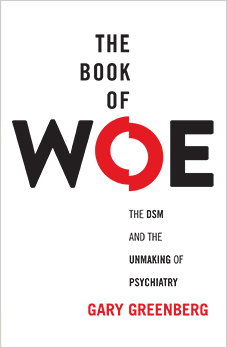Speaking of death wishes, the APA may be considering taking out a contract on Joel Dimsdale. He was the head of the Somatic Symptoms Disorders work group, the DSM-5 committee in charge of revising criteria for, you guessed it, psychosomatic disorders. That category is a quagmire, largely because of the confusions we’ve inherited from four hundred years of mind/body dualism, but that’s a story for a different day. The story for today is what Dimsdale said to ABC News.
Background: The DSM-5 is introducing Somatic Symptoms Disorder a diagnosis for which patients will qualify if they have “one or more somatic symptoms that are distressing and/or result in significant disruption in daily life,”‘ and if they have “persistent thoughts about the seriousness” of the symptoms, “persistent anxiety” about them, or devote “excessive time and energy” to them. Up late at night googling that pain in your gut? Be careful, you might be mentally ill.
I’d fully deconstruct this, but I’m supposed to be proofreading my book, and besides I trust you can see just how stupid this diagnosis is. In case you can’t then check out Allen Frances’s blog about it. The point here is what happened when ABC asked Dimsdale to comment on the objections being raised by people whose “somatic symptoms” are severe or complex enough to make persistent thoughts and anxiety inescapable and who must devote lots of time and energy (sat in a waiting room lately?) to them. Adding psychiatric diagnosis is just insult to injury, they said, and will only help doctors–who famously can’t stand patients who refuse to have something they can cure–dismiss them as nutcases.
“Some people feel like a diagnosis is a Scarlet Letter, but actually those in the DSM-4 were quite stigmatizing and pejorative,” Dimsdale said, by way of justifying the change. You would think that a guy smart enough to be a doctor would not invoke a novel whose villain has the same last name as he does, who is in fact one of the most notorious bad guys (and hypocrites) in American literature, but that is not the dumbest thing he said. The dumbest thing he said was, “If it doesn’t work, we’ll fix it in the DSM-5.1 or DSM-6.”
Not that this is not exactly the way that the DSM-5 leaders think. Indeed, it’s a version of something they’ve said repeatedly: that the DSM is a living document, not a Bible. (Forgetting, of course, that many religious people, although perhaps not Hawthorne’s Dimmesdale, think the Bible is a living document.) But to say this in the context of explaining a diagnosis that could be applied to just about anyone with a serious or debilitating disease, to acknowledge that they (and the rest of us) will be the involuntary subjects of a massive public health experiment, to bring attention to the APA’s apparent obliviousness to the real world effects of the DSM, to what happens to people when they are diagnosed and undiagnosed–really, I’ve been around this story for two years now, and even I find this shocking.
I’d say the APA would have to clean up this mess. But they’ve gone into hiding. Or more accurately, they’re just running out the clock, which they can do because they own the ball. But I wonder if behind the scenes they’re taking Dr Dimsdale out to the woodshed. Or the stocks.
Update: A reliable source assures me that Dimsdale knows full well who his namesake is and was just making an inside joke. Which is pretty funny, I’ll admit, although I doubt he intended all the layers of irony. But (and this is admittedly the pot calling the kettle black) it’s sort of cavalier, given the stakes. You gotta know your audience.















